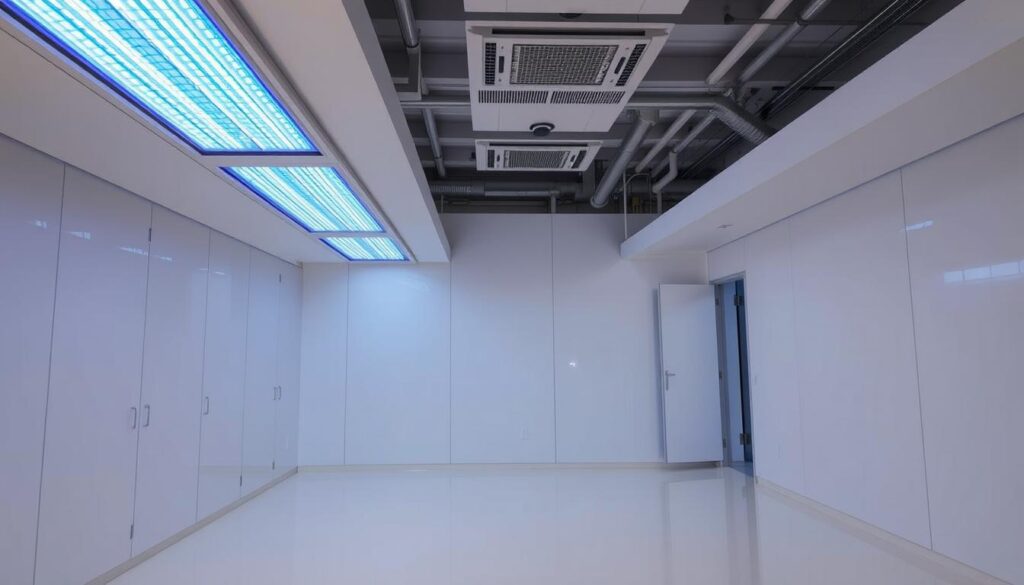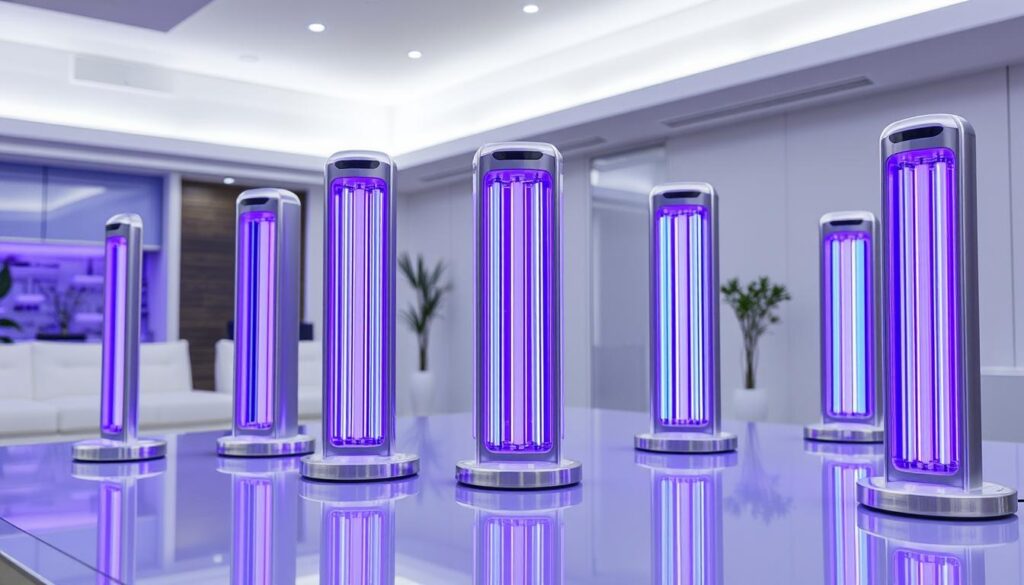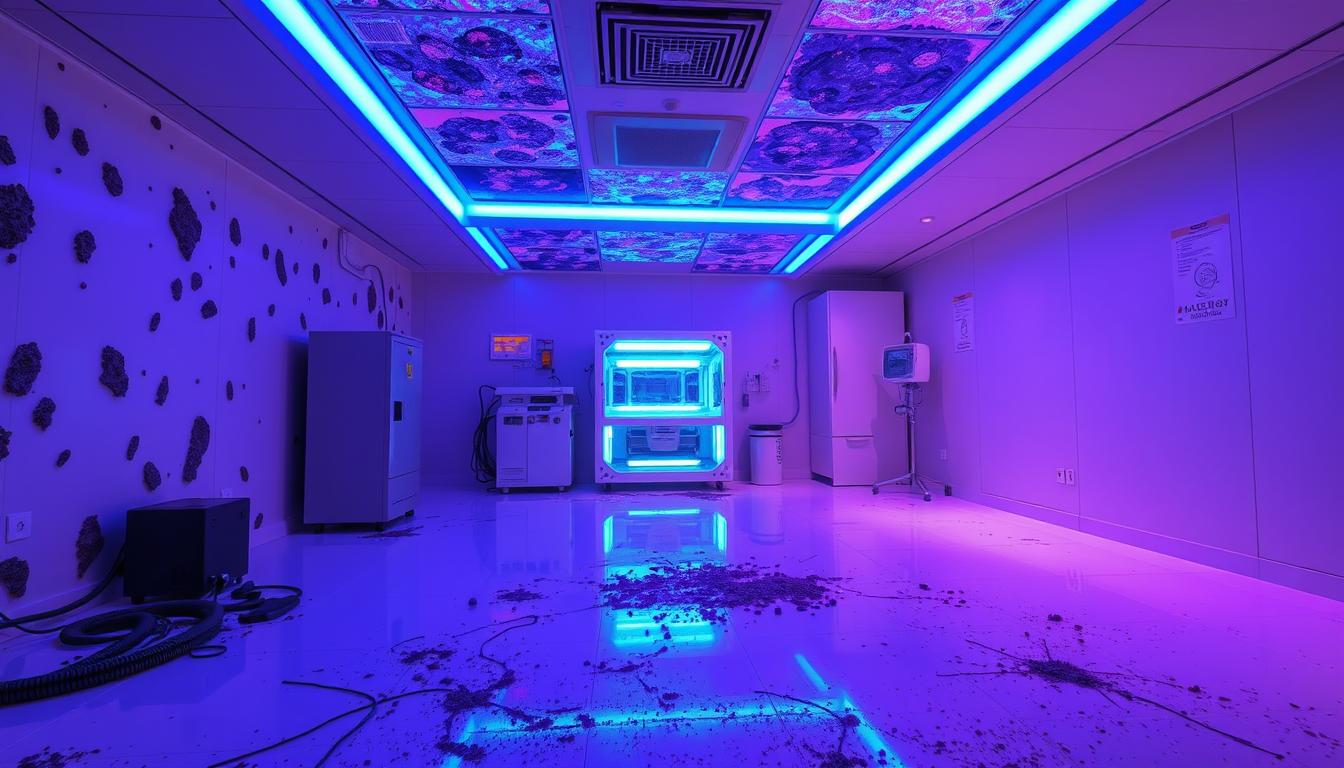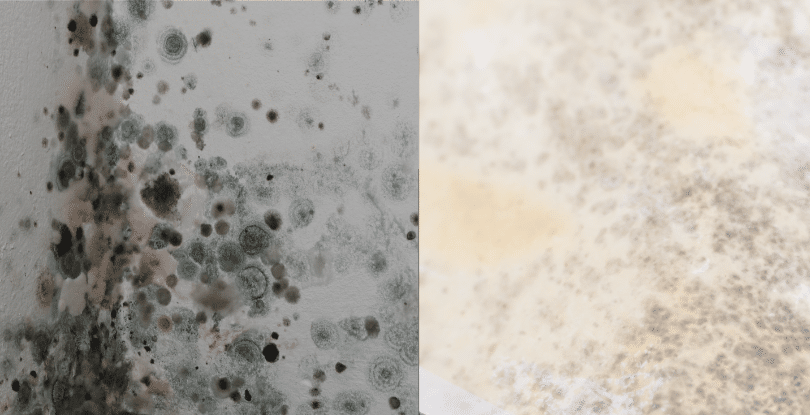Does UV Light Kill Mold?
Did you know UV light can kill up to 99.9% of mold cells if used right? This shows how powerful UV technology is against indoor mold. As a mold expert, I’m here to guide you on using UV light to get rid of mold and keep your home healthy.
Mold is a big problem that can harm our homes and health. It includes black mold and other types that grow in damp, poorly aired places. This guide will dive into UV light’s science, its mold-killing power, and how to use it in mold removal.
Key Takeaways
- UV light can effectively kill up to 99.9% of mold cells when applied correctly.
- Permanent UVGI systems installed in HVAC units can cost an average of $9000.
- UV light can prevent mold growth on evaporator coils and drain pans in HVAC systems, enhancing indoor air quality.
- Studies have shown that UV light is effective in reducing fungal contamination within air-handling units.
- UV light offers a rapid and chemical-free way to eliminate mold, making it a valuable tool in your mold remediation arsenal.
Understanding Mold: Types and Health Risks
Mold is a fungus that helps break down organic matter. But, it can be harmful when it grows in our homes. It comes in colors like black, green, white, and orange. Mold grows well in damp places and can cause health problems, including breathing issues and skin irritation.
Common Mold Species in Homes
Homeowners often find these mold types indoors:
- Stachybotrys chartarum (black mold)
- Aspergillus
- Penicillium
- Cladosporium
- Alternaria
Health Implications of Mold Exposure
Mold exposure can harm people, especially those with weak immune systems or allergies. Symptoms include:
- Respiratory issues like coughing, wheezing, and shortness of breath
- Allergic reactions such as sneezing, runny nose, and watery eyes
- Skin irritations and rashes
Ideal Conditions for Mold Growth
Mold loves damp places like bathrooms and basements. UV-C germicidal lamps can help stop mold from growing. They kill mold spores, preventing them from spreading.
Mold can be a serious problem in homes, but with the right mold prevention strategies and the use of UV-C germicidal lamps, homeowners can effectively control and eliminate this fungal threat.
The Science Behind UV Light Technology
UV light, or ultraviolet radiation, is a strong tool against mold. It’s divided into UV-A, UV-B, and UV-C based on its wavelength. UV-C is best for killing germs, including mold, by damaging their DNA and cells.
UV-C light harms mold cells, stopping them from growing and killing them. How well UV light kills mold spores depends on the light’s intensity, how long it’s on, and the mold type.

Many studies show UV-C lamps and ultraviolet radiation are great for killing mold. A 2023 study found UV light can cut mold growth on surfaces by up to 90%. The NIH also found UV light kills Aspergillus niger, a common mold, very well.
UV light effectively killed airborne mold spores in hospital environments, reducing the risk of contamination in sensitive areas, as demonstrated by a study from Harvard Medical School.
The science is clear: UV-C technology is a powerful mold fighter. By understanding how ultraviolet radiation disinfection works, we can keep our homes and workplaces clean and healthy.
Does UV Light Kill Mold?
UV light, especially UV-C, is a promising way to kill mold. Studies show it works well against common mold types like Aspergillus niger. It also cuts down on mold spores in the air inside HVAC systems.
Effectiveness Rates of UV Treatment
UV light between 255nm and 280nm can kill up to 99.9% of mold cells. It usually takes one to three hours to do so. When used with other methods, it can remove all mold spores.
Air purifiers with UV lights can remove up to 99% of mold spores from the air.
Scientific Evidence and Studies
Studies back up UV light’s effectiveness against mold. A Duke University Medical Center study found UV light cuts drug-resistant bacteria by over 97%. Another study showed UV light treatment lowered fungal levels in air units by 4 months.
Limitations of UV Light Treatment
UV light is very effective but has its limits. Its success depends on how long it’s used, its intensity, and the mold type. It works best when directly on mold and might not reach all areas.
UV light is a strong tool against mold, killing up to 99.9% of cells when used right. Knowing its strengths and weaknesses helps everyone make better choices against mold.
Types of UV Light for Mold Treatment
When tackling mold, the right ultraviolet (UV) light is key. UV-C germicidal lamps are top-notch for this task. They emit UV-C radiation that damages mold cells, killing them off.
UV light is used in many ways, like cleaning water and surfaces. For mold, UV-C lamps are best. They can kill up to 99.9% of mold cells. These lamps come in various sizes for different needs, like air purification or treating moldy areas.
Choosing the right UV lamp depends on the area you need to treat. Make sure to install and place the UV light correctly. With UV-C germicidal lamps, you can fight mold and keep your space healthy without harsh chemicals.

How UV-C Light Destroys Mold Cells
Ultraviolet (UV) light is a strong ally in the battle against mold. UV-C light, a specific part of the UV spectrum, is especially good at killing mold cells. It does this by messing with their DNA and structure. This damage stops mold from growing and eventually kills it.
DNA Disruption Process
When mold cells meet UV-C light, their DNA gets messed up. This makes it hard for the cells to copy themselves. Without this ability, mold can’t grow or spread.
Timeline for Mold Elimination
It usually takes 1-2 hours of UV-C light to kill mold. The UV-C light goes deep into the mold cells, causing lasting damage. This makes it impossible for the mold to survive.
Factors Affecting Treatment Success
The success of UV-C light in killing mold depends on a few things:
- Light Intensity: Stronger UV-C light is more effective at killing mold.
- Exposure Duration: Longer exposure times help ensure all mold is killed.
- Mold Species: Some mold types are more resistant to UV-C light than others.
- Environmental Conditions: Humidity, temperature, and surface type can affect UV-C light’s success.
Knowing how UV-C light works and what affects its success helps us use it to fight mold. This knowledge is key for both homeowners and professionals.
UV Light Equipment and Installation Guide
UV-C lamps are key in fighting mold. They send out ultraviolet light that breaks down mold spores. This makes them unable to grow.
It’s important to place your UV light system right. Keep it about two inches from the moldy area. Make sure no other lights are on to get the best results.
Be careful when you handle UV bulbs. Wear gloves and eye protection to avoid harm. This keeps you safe and the equipment working well.
UV-C lamps are great for getting rid of mold. They’re safe, easy to use, and work well. They also cut down on mold spores in the air.
“UV-C light, with a wavelength range of 200 to 280 nanometers, is the most effective at disrupting the DNA of mold spores.”
New UV tech makes it easier to fight mold. Now, you can find portable UV-C devices and smart HVAC systems. These are great for anyone who wants to keep their space clean.
Follow this UV light sanitizer guide to use UV-C tech safely. It will help you get rid of mold and make your space healthier.
Safety Precautions When Using UV Light
Using UV light for mold remediation requires top safety. UV light is powerful against mold but can be risky if not used carefully. Homeowners and professionals must know the safety rules to protect themselves and others.
Personal Protection Requirements
UV light can harm your eyes and skin. You need UV-resistant eyewear, like goggles or face shields, and gloves. Also, cover any skin to avoid burns or harm.
Room Preparation Guidelines
Prepare the room before using UV light. Move all people and pets out. Cover or remove sensitive items and surfaces. This protects them from UV light damage.
Treatment Duration and Exposure Limits
UV light treatment lasts 1 to 2 hours, depending on the room size and mold severity. But, exposure time must be limited to avoid harm. Watch for signs of discomfort and stop treatment if needed.
By following these safety steps, you can safely remove mold with UV light. Always put the health and safety of everyone first.
Combining UV Treatment with Other Mold Removal Methods
UV light is a powerful tool against mold, but using it with other methods can make it even better. Cleaning with bleach and water can help, but UV light has big advantages. It doesn’t use harsh chemicals and can reach spots manual cleaning misses.
UV light works by damaging mold cells, stopping them from growing. It can kill up to 99.9% of mold in just one to three hours. This is much better than many other ways to fight mold.
Other methods, like cold thermal fogging, can also kill mold. But they might harm sensitive parts, like HVAC boards. UV light is safer and more precise. It’s used in places like hospitals to keep the air clean, showing its effectiveness.
| Mold Remediation Technique | Effectiveness | Application |
|---|---|---|
| UV Light Treatment | Up to 99.9% mold eradication | Basements, HVAC systems, air purification |
| Bleach and Water Solutions | Moderate effectiveness | Surface cleaning |
| Cold Thermal Fogging | Moderate effectiveness | Airborne mold spores |
For the best results, using a mix of mold-fighting methods is key. Combining UV light with other effective techniques can lead to lasting success in battling mold.
“UV light can eradicate up to 99.9% of existing mold cells when applied for one to three hours.”
UV Light Applications in HVAC Systems
UV light technology is a powerful tool against mold in homes and buildings. It’s especially effective in HVAC systems. By adding UV lights to air conditioning units, you can keep the system mold-free and improve indoor air quality.
UV-C light works by damaging mold spores’ DNA, stopping them from growing. In HVAC systems, these lamps sanitize the air. This improves indoor air quality and lowers the risk of mold-related health problems.
- UV lights in HVAC systems indirectly kill mold spores and other organic compounds like bacteria, viruses, and some volatile organic compounds (VOCs).
- HVAC professionals recommend installing UV lights inside air handlers and ductwork to neutralize mold spores passing through them.
- Mold growth on the evaporator coil of an air conditioner can lead to a loss in energy efficiency, potentially causing the coil to freeze over if left untreated.
- UV lights in air handlers and ductwork also prevent viruses and bacteria from growing in homes, in addition to reducing the toxicity of VOCs.
Homes with basements often benefit the most from UV light applications. Basements have the right moisture for mold and mildew to grow. By adding UV-C germicidal lamps to the HVAC system, homeowners can manage mold and stop spores from spreading.
| Benefit | Impact |
|---|---|
| Mold and Microbial Inactivation | UV-C light disrupts the DNA of mold spores, bacteria, and viruses, preventing their growth and spread. |
| Improved Air Quality | By neutralizing organic compounds, UV lights enhance the overall indoor air quality, promoting a healthier living environment. |
| Energy Efficiency | UV light treatment helps prevent mold buildup on HVAC components, maintaining optimal system performance and energy efficiency. |
UV light technology is very effective, but it may not work against all mold types. Some mold, like Aspergillus niger, is harder to kill with UV-C light. It might need longer exposure or other treatments. Also, UV light can’t reach mold in porous surfaces, like walls or behind materials.
To get the best results, talk to HVAC professionals. They can help you choose and install UV-C germicidal lamps. This proactive step can make your indoor environment healthier and mold-free, giving you peace of mind.
Prevention Strategies and Maintenance Tips
Stopping mold growth is key to a healthy home. As an expert, I suggest a plan that includes watching for moisture and controlling humidity. This keeps your home safe from mold.
Regular Monitoring Practices
It’s important to check your home for moisture and potential mold spots. Look for leaks around roofs, windows, and pipes. Also, keep an eye on humidity and air flow. Catching problems early can stop mold before it starts.
Humidity Control Methods
Keeping humidity levels low is a great way to fight mold. Use dehumidifiers to keep humidity between 30-50%. This makes it hard for mold to grow. Also, make sure bathrooms and kitchens have good air flow to keep humidity down.
Using UV light treatments along with these steps helps keep your home mold-free. Regular checks and managing humidity are crucial. They help avoid the damage and health risks mold can cause.
FAQ
What is UV light and how does it work against mold?
UV light comes from the sun and artificial sources. UV-C light kills mold by damaging its DNA and cells. This stops mold from growing and eventually kills it.
What are the common types of mold found in homes?
Homes often have mold like Stachybotrys chartarum (black mold), Aspergillus, and Penicillium. Cladosporium and Alternaria are also common. These molds grow in damp places and can harm your health.
How effective is UV light in killing mold?
UV-C light can stop mold growth and cut down mold spores in the air. But, how well it works depends on several things like how long it’s on, how bright it is, and what kind of mold it is.
What are the different types of UV light used for mold treatment?
UV-C light is best for killing mold. UV lamps vary in size and are used for cleaning air, surfaces, and more.
How does UV-C light destroy mold cells?
UV-C light harms mold cells’ DNA and structure, a process called photodamage. This stops mold from growing and eventually kills it. It usually takes 1-2 hours for mold to be eliminated.
What are the safety considerations when using UV light for mold treatment?
Wear UV-resistant eyewear and gloves when using UV light. Make sure the room is empty and covered or removed any sensitive items. Stay away from UV light to avoid eye and skin damage.
Can UV light be combined with other mold removal methods?
Yes, UV light can work with cleaning methods like bleach and water. UV light is better than manual cleaning and fogging machines because it doesn’t use chemicals and can reach hidden areas.
How is UV light used in HVAC systems for mold prevention?
UV lamps in air conditioning units keep the HVAC system mold-free. This method is effective because it treats the air in the building, improving air quality and preventing mold.
What are some effective mold prevention strategies?
To prevent mold, regularly check moisture levels, control humidity, and use UV light treatments. These steps can help keep your home mold-free.




